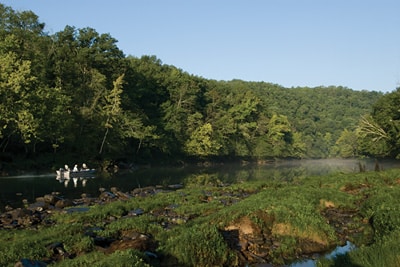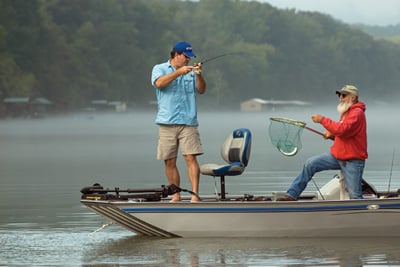Owning and operating a modestly priced powerboat is still something many Americans can afford — and justify — even when the stock market isn’t soaring. To prove this point, I went fishing.
It started last summer with a conversation with a co-worker. My contention was that a weekend on the water isn’t any more expensive than a golf outing or a road trip to a football game, and still represented a bargain in terms of vacation spending. Various sums were batted about, and we finally agreed that something like $400 would suffice for a two-day golf getaway for two or a tailgate adventure for four. Could I pull off a fishing trip for the same coin? Only one way to find out: Take a road trip with a relatively thin wallet.
Step one was tacking a couple of extra days onto an existing business trip to Springfield, Missouri. Once there, I’d rendezvous with an old friend and then head for the lake…or the river…or where? And with what?
The Perfect (Borrowed) Boat
The next best thing to owning a boat is being able to borrow one from a manufacturer’s demo fleet — it’s one of the perks of being a boating writer. A moderate-size aluminum fishing boat would be the way to go, and it just so happens that Missouri is home to several of the country’s premier aluminum-boat builders, including G3, which had recently introduced a new model: the Eagle 176.
The 176 is an interesting new concept for G3. It’s built on an economical, easy-planing jon-boat hull, but has the deck configuration of a dual-console bass boat, with pedestal fishing chairs front and back, plus livewells, a trolling motor and a fish finder for productive outings. Weighing in at a little more than 1,000 pounds and measuring a bit less than 18 feet, the boat would be easy to tow through the foothills — even with the midsize Toyota Tacoma we’d be using.
We test so many boats with big motors, when the reality is that 50 horsepower and under dominate the recreational market — so for this adventure, we went with a 50 hp Yamaha. The light weight of the boat would ease the cost at the gas pump for the Tacoma, and the modest motor would do the same for the boat.
Into the Ozarks
Even in five o’clock traffic, Route 65 south out of Springfield gives us a clear shot down the roller-coaster undulations of the four-lane road, crossing the southern Missouri hills, past the middle-American entertainment capital of Branson and over the state line. Twilight finds us in an Arkansas supermarket, stocking up on chips, beef jerky and other essentials. Our cabin at Lindsey’s Resort on the Little Red River in Heber Springs (less than $100 per night) comes with a kitchen, so we figure to save a few bucks by bringing groceries with us.
Route 65 goes two-lane and picks up some curves and more hills. But it’s hard to see the scenery by headlight, so the primary source of entertainment for the remainder of the evening drive is high-school sports and hunting reports from the AM side of the radio.
It’s after 11 p.m. when we find our way through Heber City and onto Rainbow Loop Road. Lindsey’s is buttoned up for the night, but they’ve left the keys to our cabin in the door lock. It’s that kind of place.
Low Water
There’s mist on the water when the alarm sounds at 6:00 a.m. sharp. Had we known that trout fishing isn’t just an early morning sport, we might have slept in. But there is a boat to launch.
Lindsey’s sits on a high bank above the river, with long hinged gangways leading down to the floating docks. I soon learn the reason for this arrangement: Water levels on the Little Red can fluctuate as much as 8 or 10 feet within a couple of hours, depending on the amount of water released through the hydroelectric plant just upstream at the Greer’s Ferry Dam. As a result, there’s no boat ramp at the resort; we’ll have to drive a couple of miles to the state park at the foot of the dam to put in.
“Might be a bit tricky to launch in low water,” Jim Lindsey advises when we stop by the tackle shop. “You might have to wait until they run some water through the dam this afternoon.” Jim is one of the three generations of Lindseys who lives on site and oversees all aspects of the resort operation. The phrase “family style” certainly applies.

Anxious to get on the water, we decide to take a chance. After all, the 176 needs only a few inches of water to float. Two miles up the road, we have second thoughts as we survey the steep launch ramp at J.F. Kennedy State Park. We’re looking at a stretch of shallow water with a nasty collection of refrigerator-size boulders breaking the surface. If there were kids along, and trout fishing wasn’t the primary mission, it might make more sense to launch above the dam and spend the day exploring the expansive waters of Greer’s Ferry Lake.
But we’re here to catch trout, and after giving the river a bit of study, we decide to wade out and pole the boat through the fairly short stretch of rocky shoals below the dam, then use the trolling motor to feel our way downstream to the deep-water pool at the resort.
There are some dicey moments right at the beginning when we have to jump into thigh-deep water to guide the boat through a spillway lined with a collection of nasty rocks. Then it’s just a matter of driving with extreme caution, watching the depth finder and picking our way downstream for the next couple of miles. The river depth alternates between 6-inch shoals and 10-foot pools — good thing we didn’t bring a bigger boat.
But size is relative. Once at Lindsey’s docks, we suddenly become the highliner of the fleet. The resort rents basic jon boats with 15 and 25 hp motors, and by comparison, the carpeted decks and tricked-out interior of our 176 seems downright luxurious, while the 50 hp Yamaha is the biggest motor at the docks.
**Out for Trout
**Our harrowing downriver drift leaves us hungry for something more substantial than the blueberry breakfast bars we stashed aboard. So with the staff’s assurances that the fishing action will last throughout the day, we follow our noses into the Pot O’ Gold for country ham and fresh biscuits served with a local favorite: chocolate gravy. Yep, it tastes as…good…as it sounds.
Since we’re new to trout fishing, and to the Little Red, we’re happy to find some local knowledge in the person of Sam Lester. Sam grew up on the river and spent more than 30 years as a fisheries biologist for the state. During that time, he also organized numerous projects to get children involved in fishing, and he’s guided for customers at Lindsey’s since the early days of the resort.
There are a lot of fish in the Little Red, he says, thanks to the state hatchery just upstream that releases a quarter-million rainbow trout into the water each year. But anglers also have a chance of catching brook and native cutthroat trout, as well as the local heavyweight, the brown trout. In fact, the world-record brown trout was caught in these waters, and a replica of the 40-pound monster is on display at Lindsey’s tackle shop.
Fishing strategies vary with water conditions, Sam tells us. Right now, the river is uncharacteristically murky because of recent rains, so he tells us we’d do better with worms and marshmallows — seriously.
“Trout swim low and look up for their food,” he explains, “so you use the marshmallow to get the worm floating a bit off the bottom, and maybe add a few bits of corn to sweeten the offering.”

Whatever the rationale, this simple rig works, and we spend the morning reeling in rainbows, with the occasional brook and cutthroat tossed into the mix. The big browns elude us, possibly because of the murky water and our fishing techniques.
“Normally the river runs clear, and you can cast big surface plugs into the moving water to attract the browns,” Sam says. No matter; by the time we return to the docks, we’ve caught and released dozens of fish, and kept a few of the nicer ones for the grill.
Later that evening, while relaxing on the porch with a couple of cold ones, we do a quick review of the numbers. The 50-horse outboard hadn’t made much of a dent in the boat’s fuel supply and even allowing for longer runs the next day, we’d probably get by with less than 10 gallons — about $35 at the time. The drive down burned just under half a tank, so we figured in about $65 for the round trip. Two nights in the cabin had run $160; a pair of fishing licenses was $42; 10 bucks for bait, another 10 for breakfast, and maybe 40 for groceries and drinks.
When all was said and done, we’d barely cracked the $300 mark and had plenty left to splurge on a steak dinner the next afternoon. All things considered, we’d done a lot more on a trio of Ben Franklins than most folks who head to the stadium or the links — and had a cooler full of fresh fish to boot.








